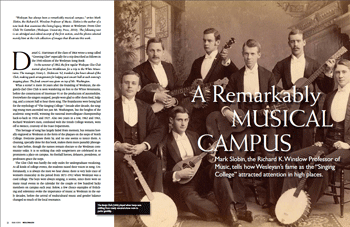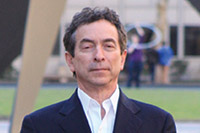A Remarkably Musical Campus
“Wesleyan has always been a remarkably musical campus,” writes Mark Slobin, the Richard K. Winslow Professor of Music. Slobin is the author of a new book that examines this living legacy, Music at Wesleyan: From Glee Club To Gamelan (Wesleyan University Press, 2010). The following text is an abridged and edited excerpt of the first section, and the photos selected merely hint at the rich collection of images that illustrate this work.
 Daniel G. Harriman of the class of 1864 wrote a song called “Greeting Glee” especially for a trip described as follows in the 1940 edition of the Wesleyan Song Book:
Daniel G. Harriman of the class of 1864 wrote a song called “Greeting Glee” especially for a trip described as follows in the 1940 edition of the Wesleyan Song Book:
In the summer of 1862, the first regular Wesleyan Glee Club started afoot from Middletown for a trip to the White Mountains. The manager, Henry L. Dickinson ’62, traveled a few hours ahead of the Club, making quick arrangements for lodging and concert hall at each evening’s stopping place. The final concert was given on top of Mt. Washington.
What a scene! A mere 30 years after the founding of Wesleyan, the elegantly–clad Glee Club is seen wandering on foot to the White Mountains, before the construction of Interstate 91 or the production of automobiles. Everywhere the singers stopped, people were glad to offer them food, lodging, and a concert hall to hear them sing. The foundations were being laid for the mythology of “The Singing College.” Decade after decade, the singing young men ascended not just Mt. Washington, but the heights of the academic song world, winning the national intercollegiate championship back–to–back in 1926 and 1927. Also two years in a row, 1962 and 1963, Richard Winslow’s men, combined with the Smith College women, went off to Mexico, courtesy of the State Department.
This heritage of song has largely faded from memory, but remains literally engraved at Wesleyan in the form of the plaques on the steps of North College. Everyone passes them by, and no one seems to notice them. A cleaning, specially done for this book, makes them more passably photogenic than before, though the names remain obscure to the Wesleyan community today. It is so striking that only songwriters are celebrated in so prominent a place on campus. No football heroes, debaters, presidents, or professors grace the steps.
The Glee Club was hardly the only outlet for undergraduate vocalizing. At all kinds of college events, the students raised their voices in song. Unfortunately, it is always the men we hear about; there is very little trace of women’s musicality in the period from 1872–1912 when Wesleyan was a coed college. The boys were always singing, it seems, since there were so many ritual events in the calendar for the couple or few hundred lucky members on campus each year. Below, a few choice examples of frolicking and solemnity evoke the importance of music at Wesleyan in the early decades, before the arrival of multicultural music and gender balance changed so much of the local resonance.
The Glee Club World
What were the boys singing, when not atop Mt. Washington but back in the Chapel? The program for November 19, 1869, illustrates three kinds of pieces: college songs, classical music favorites—often from opera—and light fare. In a wry Wesleyan way, the composer of “Viva la Wesleyan” is given—misspelled—as “unbekannt,” German for “anonymous,” just as Pat Molloy’s solo is ascribed to “umlaut,” the German double–dot sign over o and u. “Johnny Schmauker,” sometimes given as “Johnny Schmoker” in programs, looks like a German parody number of the type popular in that era. Whatever it symbolized, the song began its life at Wesleyan. According to an 1869 account in the Western Collegian, “‘Johnny Schmoker’ was first brought before the American public by the Glee Club of the Wesleyan University, Conn.”
In today’s a cappella age, opera seems a surprisingly large part of the repertoire of choice. In 1869, arias were popular music, widely distributed in the sheet music that most people kept in their homes as part of the common American habit of friends and family singing around the piano.
The reviews for the concert at the Tremont Temple in Boston speak eloquently to the fame Wesleyan’s Glee Club had secured by 1884. In Wilkes–Barre, Pennsylvania, the Record rates the group as “positively the best,” an opinion seconded by the Newark Advertiser. The yodeling of Mr. G. D. Beattys, which he repeated numerous times on demand, was typical of the age. Traveling troupes of Swiss and Tyrolean Alpine singing families crisscrossed America as early as the 1850s.
The 1869 “Grand Union Concert” of the Yale and Wesleyan Glee Clubs offers a rare chance to size up choruses side by side. This benefit concert featured solo and joint numbers, again with many German and classical items, as well as what we might call “novelty” pieces, such as “Solomon Levi,” a very popular song we would certainly ban as anti–Semitic today. The bundling of a Spanish, Chinese, and probably Balkan (“Fatinitza”) number speaks to other versions of ethnic and international stereotyping.
What “The Pope” said about Catholicism is left to our imaginations. The second–half opener, “George Washington,” rounds out the standard sampling of popular styles of the day, which always included the theme of patriotism.
The transportation is as eye–catching as the song list. One could simply take the train from Middletown to New Haven and back, and $1.00 would cover both ticket and transportation to and from the stations. Sometimes the old days were actually more convenient.
The Wesleyan students probably expected to come out on top in this Connecticut choral rivalry. Back in 1873, the Argus contentedly made this observation:
We clip the following from a Meriden paper: “We were somewhat disappointed at the singing of the Yale club, though in their college songs (their legitimate music) they did fairly. According to our humble judgement, the ‘Wesleyans’ of Middletown far surpass them.”
We have all kinds of sources that support this boosterism.
Take the account of the 1899 Glee and Mandolin Club trips, which took 25 students south to New Jersey, Pennsylvania, West Virginia, and Washington, D.C: “The trip covered in all about 1,900 miles, and the clubs traveled the entire route in a private [train] car. . .The first concert was given in the YMCA Hall, Philadelphia, before an audience of over 1,300.” Arriving at the nation’s capital, the students received the ultimate welcome from William McKinley: “The President received the clubs informally in the cabinet room for a few moments, shaking hands with each man.” They then gave a concert at the Metropolitan Church, of which McKinley was a member. Various wives of senators, congressmen, and judges organized the event. In that era, it was women who made sure concert life was a strong part of local entertainment, even at the highest levels of government.
The 1901 Christmas trip yielded the same results. At a concert in Camden, New Jersey, “Almost every number was enthusiastically encored, and just before the last, the clubs were given a fine ovation. The whole audience of nearly 2,000 rose to their feet and cheered and waved a salute for several minutes.” The President was just as welcoming, but there was a hitch: “President McKinley received the clubs in the cabinet room of the White House. At that time he expressed regret that it had been necessary to cancel [his] invitation for a concert on Monday. . . and urged the clubs to stay another day [which they couldn’t do, due to a concert in Camden]. He promised, however, to hear the clubs sing next June, when he proposes to visit Wesleyan.”
Perhaps McKinley would have made good on that promise, but he was destined not to hear the clubs again, as he met an assassin’s bullet a short time later, in September of that year. Given the great prestige of glee clubs, it is not surprising that many students tried to form one, and that not all of them had an easy time finding their niche, though one group of 1873 managed a breakthrough:
We well remember under what inauspicious circumstances the Arion Glee Club was organized. Various were the predictions as to their fate. Some few prophetic ones foretold for them a most “inglorious fizzle.” Others, feeling that the college greatly needed a glee club, gave them their best wishes, but could offer few words of encouragement. . .they persevered with commendable zeal, till success crowned their efforts. Everywhere they sang, they found an appreciative audience. For two years on many public occasions connected with the college, they have furnished excellent music, free, gratis. Thus many a dime has lingered yet a little longer in our pockets ere it went the way of all the rest.
Such was the power of glee clubs that part of the profits from their tours went to support athletic programs, an unthinkable system given today’s primacy of athletics on American college campuses. An 1889 program includes a “Base Ball Bulletin” that demonstrates this linkage.
Durability marks the history of glee clubs. In 1911, we see that “a picked Quartette from ‘The Singing College of New England’” is offering pretty much the same fare as their predecessors decades earlier: classical music, German numbers, exotic novelty pieces, and comic items to present “an ideal entertainment with an abundance of humor.” Some of that fun must have come in “De Coppah Moon,” clearly a minstrel–show item that is either written by a different poet named Shelley or is a travesty of the great Romantic poet’s work, a tradition dating back to the Shakespeare spoofs of the mid–19th century. We see strong continuity in even the physical presence of the Wesleyan a cappella groups of yore. The Jibers not only lasted for decades, but kept the same outfits and hairstyles over 45 years.
The Glee Club won the national championship in 1926, an event that tells us just how important such organizations were on campus nationwide.
What did the group sing as it battled its way to victory? The program is heavy on classical music, with a hymn, and leavened only by “Gipsy John,” perhaps a version of an old British ballad about the lady who leaves her lord for a “Gipsy.” The listing of “orchestra” shows the continuity of instrumentalists alongside vocalists. This might be the “Trio” of piano, violin, and flute, as opposed to “The Serenaders,” who offer music for “dancing until 1 a.m.,” played by a jazz–age combo of saxophones, trumpet, sousaphone, drums, and banjo.
The Glee Club’s stability and primacy clearly has to do with its important function as an outreach and recruitment tool for the College, as already noted in 1899, the year of the first White House reception:
The Glee Club, although not receiving so great public recognition as some of the other branches of student activity, has it in its power to do fully as much good for the college. It is no small advantage to have a good glee club make an occasional incursion into regions where we are little known. Singing Wesleyan songs is certainly a far more effective manner of calling attention to the college than are circulars and advertisements, and often men are influenced by this means who could be reached in no other way.

